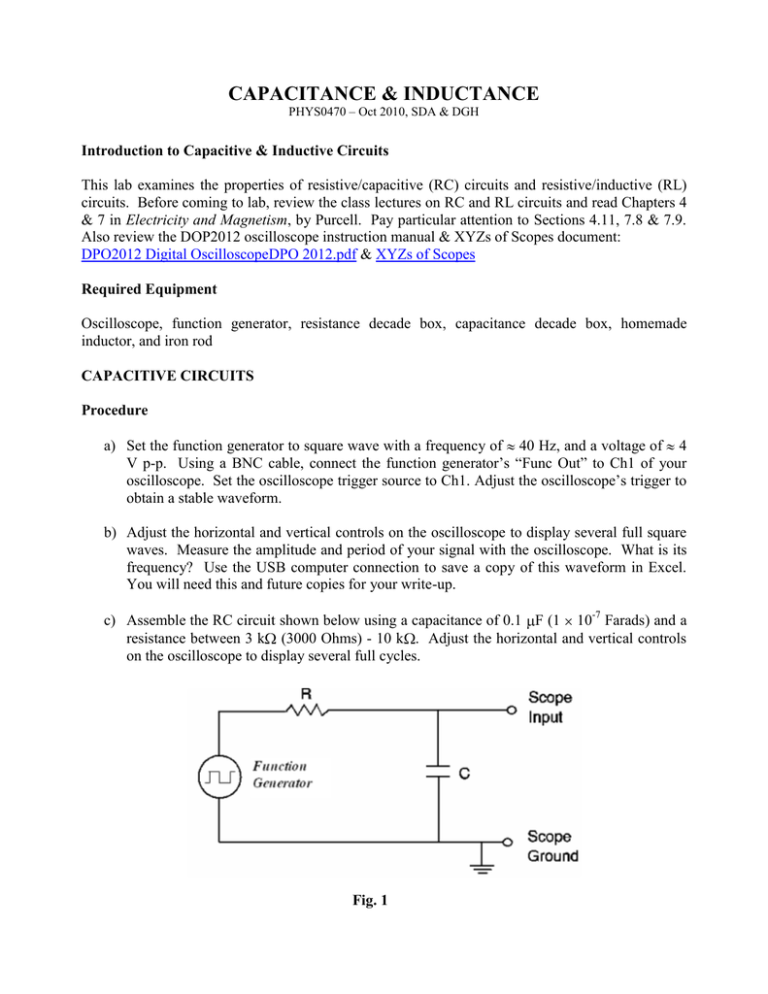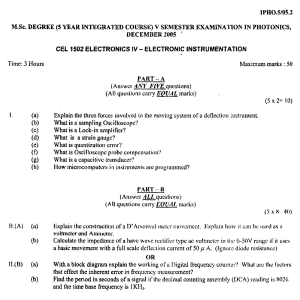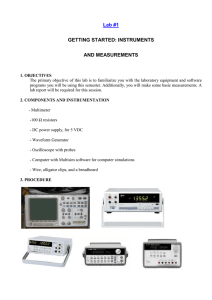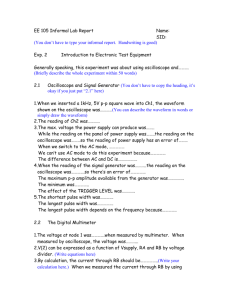Capacitance & Inductance Lab: RC & RL Circuits
advertisement

CAPACITANCE & INDUCTANCE PHYS0470 – Oct 2010, SDA & DGH Introduction to Capacitive & Inductive Circuits This lab examines the properties of resistive/capacitive (RC) circuits and resistive/inductive (RL) circuits. Before coming to lab, review the class lectures on RC and RL circuits and read Chapters 4 & 7 in Electricity and Magnetism, by Purcell. Pay particular attention to Sections 4.11, 7.8 & 7.9. Also review the DOP2012 oscilloscope instruction manual & XYZs of Scopes document: DPO2012 Digital OscilloscopeDPO 2012.pdf & XYZs of Scopes Required Equipment Oscilloscope, function generator, resistance decade box, capacitance decade box, homemade inductor, and iron rod CAPACITIVE CIRCUITS Procedure a) Set the function generator to square wave with a frequency of 40 Hz, and a voltage of 4 V p-p. Using a BNC cable, connect the function generator’s “Func Out” to Ch1 of your oscilloscope. Set the oscilloscope trigger source to Ch1. Adjust the oscilloscope’s trigger to obtain a stable waveform. b) Adjust the horizontal and vertical controls on the oscilloscope to display several full square waves. Measure the amplitude and period of your signal with the oscilloscope. What is its frequency? Use the USB computer connection to save a copy of this waveform in Excel. You will need this and future copies for your write-up. c) Assemble the RC circuit shown below using a capacitance of 0.1 F (1 10-7 Farads) and a resistance between 3 k (3000 Ohms) - 10 k . Adjust the horizontal and vertical controls on the oscilloscope to display several full cycles. Fig. 1 In this configuration, the oscilloscope is measuring the voltage across the capacitor. Since V = Q/C, this voltage is proportional to the charge on the capacitor. Use the oscilloscope to measure the time constant of this RC circuit. Save a copy of this waveform in Excel Recall, the charge on a capacitor after a voltage change at t = 0 is given by: (1) The capacitor charges to Qmax/2 at time t1/2, given by: (2) Solving for the time constant RC gives: Note: ln 2 = 0.69 (3) Compare this theoretically predicted value to the one found on the oscilloscope. Include the uncertainty due to the measurement error of t1/2. d) Now connect the oscilloscope across the resistor as shown below. Adjust the oscilloscope controls as necessary and save a copy of this waveform in Excel. Fig. 2 Since V = IR, the voltage displayed on the oscilloscope is proportional to the current in the RC circuit. Recall, the variation in I after a voltage change at t = 0 is given by: (4) Compute the time constant of this waveform. Record your measured value and associated error. How does this time constant compare with the result of part (d) and the theoretically predicted value? e) Using an additional capacitance box, find the capacitance of a pair of capacitors in parallel and the capacitance of the same pair in series. Repeat this exercise with different values of capacitance. Do your results agree with the equations used to determine the capacitance of multiple capacitors in series and parallel? f) You have been provided an unlabeled adjustable capacitor. Use the experimental techniques from above to determine its minimum & maximum capacitance. Include error. INDUCTIVE CIRCUITS Self-Inductance of a Coil Faraday discovered that a time varying magnetic flux induces an electromotive force (emf) in a conductor that opposes the change in flux. We can demonstrate this using an inductor, which in our case will be a small handmade coil. When a current passes through the coil, a magnetic field is produced that generates a magnetic flux through the coil. If the current through the coil is changing, so is the flux . From Faraday’s Law, there will be a voltage drop across the coil given by: (1) The flux through the coil depends only on the current I in the coil and some geometrical factors. Thus, we can write the induced emf V as dI/dt times a constant (defined as self-inductance L) specific to the coil: (2) For a long solenoid of length , radius r, and N turns of wire, with a uniform field B = 4 NI/c inside (the flux through each loop is then r2B), the self-inductance is: (3) The above expression for inductance L is in CGS units. The SI unit of inductance is the “henry”, where 1 henry = 1.11 10-12 sec2 cm-1. In SI units, formula 3 becomes (4) Procedure a) Measure and record the number of turns, radius and length of the homemade coil. Calculate the inductance of your coil using Eq. (3). b) Set the function generator to triangular wave with a frequency of 10 kHz and voltage of 10 Vp-p. Using a BNC cable, connect the function generator’s “Func Out” to Ch1 of your oscilloscope. Set the oscilloscope trigger source to Ch1. Adjust the oscilloscope’s trigger to obtain a stable waveform. Save a copy of this waveform in Excel. c) Assemble the RL circuit shown below using the homemade coil and a resistance of 100 . Adjust the horizontal and vertical controls on the oscilloscope to display several full cycles. Save a copy of this waveform in Excel. Fig. 1 In this configuration, the oscilloscope is measuring the voltage across the resistor. Since V = IR, this voltage is proportional to the current in the RL circuit. Use the oscilloscope to find dI/dt in amps/sec. Record your value. Fig. 2 Voltage Across R d) Now connect the oscilloscope across the homemade coil as shown below Fig. 3 e) Adjust the scope sensitivity to see several complete waveforms as shown in Fig. 4. Fig. 4 The sudden change in voltage across the indicator, VL, comes from the abrupt change in dI/dt: (5) Save a copy of this waveform in Excel and record your value for VL. Why isn’t the waveform a perfect square wave? How does the coil’s resistance affect the waveform? Use your experimental data to compute the inductance, L, of your coil and compare it with the theoretical prediction in part a) above. Make sure you are consistent in using SI units (volt, henry, ampere…). Account for any discrepancies.






